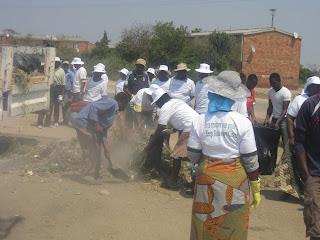Dabane Water Workshops, working together with the Bulawayo City Council and World Vision have started the de-choking and rehabilitation of the sewer lines using a jetting machine for de-choking. It is not a one day job; so far the Dabane team has started working on the Magwegwe sewers, mapping the over 2000 manholes, so as to make the process easier.
 |
| a sample of mapping manholes using google earth( magwegwe north) |
The blockage of the sewer system has been a result of people throwing in large objects into the manholes, such as heavy rocks, stones and even dead animals. In some instances tonnes of sand have been removed from the de-choked manholes. Whether the incidences are done on purpose or through ignorance one would never know. However, it was suggested that some of these blockages are done on purpose for irrigation, as trenches were seen starting from the burst manholes leading to their small vegetable gardens in the veld.
 |
| sewage flowing onto the streets into people's yards |
 |
| A clear and unblocked manhole |
The community is reminded to stop putting heavy materials into the manholes and that these sewers are for the good of the community.

